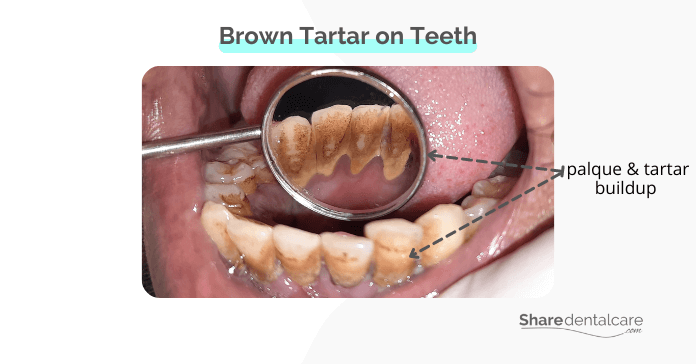Do you have brown tartar on your teeth? If so, it’s important to get it cleaned up as soon as possible. Tartar is a hardened plaque that can cause serious dental problems if left untreated. In this blog post, we will discuss the causes of brown tartar and how to remove it from your teeth. We will also provide some tips for preventing tartar buildup in the future.
What is Tartar?
Dental Plaque is a colorless, sticky film of bacteria that forms on your teeth every day. It consists of food debris, saliva, and bacteria. Plaque can be easily removed with daily brushing and flossing. However, when plaque is not removed, it hardens and turns into tartar.
Tartar, also known as (calculus), is a hard, yellow-to-brown deposit that can form on your teeth. It can extend below the gum line and cause irritation, redness, and bleeding. Tartar can’t be removed with brushing and flossing, so it is important to see your dentist for a professional cleaning.
How Does Brown Tartar Affect Teeth and Gums?
Plaque and tartar bacteria decompose sugars and starches from the foods you eat and produce acids. These acids attack teeth and irritate the gums, leading to oral health problems. The longer plaque and tartar stay on your teeth, the more damage they can do.
Tartar can cause several dental problems, including:
- Tooth decay: Tartar provides a place for bacteria to hide and thrive. These bacteria produce acids that can eat away at your tooth enamel, causing cavities.
- Gum disease: Tartar can also cause inflammation and infection of the gums, known as periodontal disease. Gum disease is a leading cause of tooth loss in adults.
- Bad breath: Bacteria that cause tooth decay and gum disease can also lead to bad breath.
In addition to these dental problems, tartar can also affect your appearance. Tartar can make your teeth look yellow, brown, and stained. It can also cause your gums to look red, swollen, and inflamed.

Factors That Increase Your Risk of Developing Brown Tartar on Teeth
Several factors can increase your risk of developing brown tartar on your teeth, tooth decay, and gum disease. These include:
- Poor oral hygiene: Plaque and tartar are more likely to build up if you don’t brush and floss regularly.
- Eating sugary and starchy foods: These foods can contribute to plaque buildup.
- Smoking: Smoking dries out the mouth and increases the risk of tartar buildup. You can read more about how can smoking cause gingivitis.
- Dry mouth: Saliva washes away food and plaque and helps to keep your mouth healthy. If you have a dry mouth, you are more likely to develop brown calculus on your teeth.
- Some medications: Certain medications, such as antihistamines and decongestants, can cause dry mouth and increase the risk of tartar buildup.
How to Remove Brown Tartar from Your Teeth?
Tartar can’t be removed with brushing and flossing. So, if you have brown tartar on your teeth, visit your dentist to remove it and treat the problems it may have caused. The treatment depends on the severity of the tartar buildup and dental problems. Treatment options include:
- Professional teeth cleaning (routine cleaning): This is a routine procedure that is performed every six months to remove plaque and tartar from your teeth. The dentist will use a special instrument (periodontal scaler) to remove the plaque and tartar from around your gum line and between your teeth.
- Scaling and root planing (deep cleaning): This is a deep cleaning treatment that is used to remove tartar from below the gum line. It is usually performed if you have an advanced form of gum disease. Scaling and root planing involves removing tartar from teeth and roots and smoothing out the rough spots on the roots to help prevent tartar buildup in the future. You can read more about why some people may experience loose teeth after deep cleaning.
Once the brown tartar is removed, your dentist will polish your teeth to leave them looking clean and shiny. You will need further treatment if you have tooth decay or gum disease. After your cleaning, your dentist will give you instructions on how to care for your teeth at home to prevent brown tartar from forming again.

Home Care Tips for Prevention
In addition to professional dental cleanings, there are some things you can do at home to prevent brown tartar from forming on your teeth. These include:
- Brush your teeth twice a day: Brushing removes plaque from your teeth. Be sure to use a toothbrush with soft bristles and toothpaste that contains fluoride.
- Floss daily: Flossing helps to remove plaque and food particles from between your teeth.
- Use mouthwash: Mouthwash can help to remove plaque and bacteria from your mouth.
- Drink plenty of water: Drinking water helps to keep your mouth moist and washes away food and plaque.
- Limit sugary and starchy foods: These foods can contribute to severe plaque buildup on teeth.
- Quit smoking: Quitting smoking is not only good for your oral health but your overall health as well.
- See your dentist regularly: Regular dental checkups and cleanings can help to remove tartar from your teeth and prevent tooth decay and gum disease.
Conclusion
Tartar, also known as (calculus), is a hard, brown deposit that can form on your teeth. It is caused by plaque that has hardened and becomes stuck to your teeth. Tartar can lead to tooth decay and gum disease. Therefore, it is important to remove it from your teeth as soon as possible. You can do this by seeing your dentist for professional teeth cleaning. You can also prevent tartar from forming on your teeth by brushing and flossing daily. By following these tips, you can keep your teeth clean and your mouth healthy.